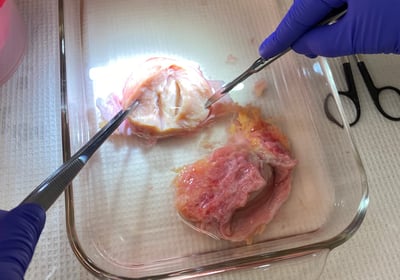Uterine Contractility
Alterations in uterine function can have significant consequences for human health, impacting conditions such as pregnancy and dysmenorrhea. At REPROCELL, we provide advanced uterine contractility assays using fresh, functional human uterine tissue to determine whether your test article induces contraction or relaxation of this critical organ.

Key Features of Our Uterine Contractility Assay
- Accurate Measurement: We determine both IC50 and pA2 values, ensuring precise analysis of your test article’s effects.
- Multiple Reference Compounds: Reference compounds including vasopressin, oxytocin, and phenylephrine are available for comparison.
- Antagonist Testing: Test article effects can be assessed in the presence of an antagonist, providing deeper insight into your compound’s action.
- Safety Assessments: We adhere to GLP regulations, ensuring your study meets the highest safety and quality standards.
- Cross-Species Comparison: For enhanced insights, we offer the option to test in both human and rat uterine tissues.
- Translation from Lab to Clinic: Isolated myometrial tissue studies have been pivotal in proof of concept studies of various drugs used to delay or induce labor, or prevent post-partum haemorrhage.
Our assay provides reliable results by simulating the natural rhythmical uterine contractions and relaxations of human tissue in organ baths. This setup allows for accurate testing of potential drug effects on the uterus. Strips of myometrium are dissected and mounted within organ baths for measurement of spontaneous or agonist-induced contractions via force transducers. Myometrial strips can also be exposed to test drugs or positive controls such as endogenous hormones, allowing measurements of contractile force, duration and frequency. Positive controls such as oxytocin or vasopressin are often employed and the effect of test drugs may be to further enhance or inhibit contractions.
The development of drugs influencing uterine tone includes important proof of concept studies in organ baths1. Atosiban, an oxytocin (OTR) and vasopressin (V1aR) antagonist which is used to delay labor, was tested in isolated tissues2, where it was shown to reduce oxytocin-mediated contractions, in advance of clinical trials. Similarly, the effects of carbetocin, an oxytocin analog, in preventing post-partum haemorrhage were demonstrated in human isolated myometrial strips3.
Case Study: Supporting HIV Prevention with the International Partnership for Microbicides
At REPROCELL, we’ve had the privilege of working with the International Partnership for Microbicides (IPM), a nonprofit organization dedicated to empowering women with HIV-prevention strategies. One of their groundbreaking innovations, the monthly dapivirine ring, provides a discreet option for HIV prevention. In 2020, this ring received a positive opinion from the European Medicines Agency (EMA), marking a significant step forward in women’s health.
Our Contribution to the Dapivirine Ring Development
IPM approached REPROCELL (Biopta) seeking a laboratory equipped to perform a uterine contractility study. After an initial consultation, we conducted an ex vivo study to determine the effects of dapivirine on uterine contractility.
Using fresh uterine tissue, our scientists were able to evaluate whether dapivirine impacted the natural contractions of the uterine muscle. Our methodology involved:
- Ethically obtaining fresh uterine muscle strips from five human tissue donors.
- Suspending the muscle strips in organ baths to simulate natural spontaneous contractions.
- Testing the effects of dapivirine, alongside oxytocin as a positive control and a negative control.
Results
Oxytocin, as expected, increased the frequency of spontaneous contractions, confirming the reliability of our system. Dapivirine, however, had no significant effect on uterine contractility, providing critical safety data for IPM’s ongoing development of the dapivirine ring.
As a result of these studies, IPM is now developing a dapivirine ring that can be used for up to three months, offering women an even more convenient option for HIV prevention.
For more information about the case study, read here: Achieve Regulatory Approval: The Dapivirine Vaginal Ring for HIV prevention (reprocell.com)
By partnering with REPROCELL, you gain access to cutting-edge ex vivo tissue models, including our human uterine contractility assays, to support the development of safe, effective treatments that positively impact women’s health worldwide. Contact us today to learn more about our services and how we can assist in your drug discovery and development efforts.
References
- Arrowsmith, S et al. J Vis Exp (2018) 131: 56639 doi: https://doi.org/10.1016/j.cophys.2019.10.006
- Goodwin, TM et al. Am J Obstet Gynecol (1995) 173 (3 Pt 1): 913-917 doi: https://doi.org/10.1016/s0002-9378(98)70312-6
- Norstrom, A et al. Acta Endocrinol (1990) 122(5): 566-568
Uterine contractility assays in our catalog
Determine whether your test article affects uterine contractility via vasopressin receptors.
Determine whether your test article affects uterine contractility via oxytocin receptors.
Determine whether your test article affects rat uterine contractility via oxytocin receptors. Can be used in comparative studies to investigate species differences.